You love your grey-muzzled companion and want to give him or her the best life possible. But where do you find the best things for senior dogs that will help them through their golden years? As an integrative veterinarian with over 25 years of experience caring for aging dogs, Dr. Julie Buzby shares her “A list” of 18 essentials for senior canine companions. Help is here.

If you share your heart and home with a senior dog, you probably already have your own list of favorite things that improve your dog’s quality of life.
As a veterinarian who has focused her career on helping senior dogs live long and happy lives, I’ve developed my own list of the best things for senior dogs too. And I’d like to share it with you.
This list represents the 18 essentials that I recommend almost universally for my geriatric patients. To make it easier to scan, I’ve divided them into three categories—senior dog comfort and mobility products, supplements and medications for senior dogs, and care and interaction products for senior dogs.
Best things for senior dogs: 4 products to promote comfort and mobility
The following things may help your senior dog stay mobile and comfortable for longer.
1. Orthopedic dog bed for senior dogs
Orthopedic beds make my list of favorite things for senior dogs because adult dogs spend over half of their lives sleeping. These dog beds can be very helpful for old, arthritic bones and joints.
My favorite dog bed for seniors is the memory foam style. But it’s not my opinion that matters, it’s your dog’s! So there may be some trial and error in finding that “can’t-live-without” dog bed for your grey-muzzled companion.
Most of my veterinary clients describe their dogs as having one particular favorite bed, which I can only assume is because it is comfortable. Often these are pricey memory foam dog beds. My clients consistently report that when they invest in a high quality, supportive bed, their old dogs sleep more soundly through the night.
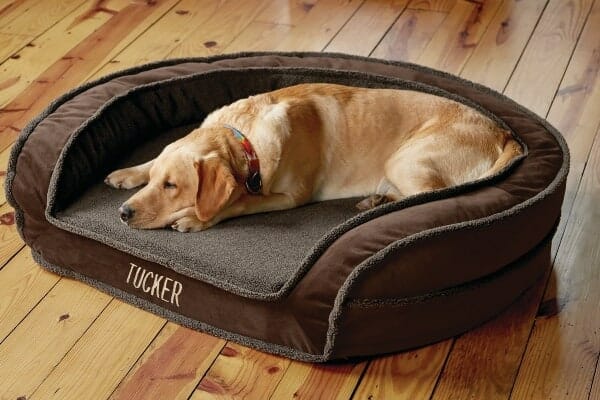
When choosing a dog bed, make sure to buy one that has a zip-off cover which is machine washable. A washable inner waterproof layer to protect the mattress from urinary accidents is a bonus too.
Beds are available from many retailers. But Orvis has a great selection, great quality, and is a favorite with my clients.
Another great option is a Barker Bed, such as the Big Barker. The University of Pennsylvania School of Veterinary Medicine performed a study using Big Barker beds for dogs with arthritis. The dogs in the study had less joint stiffness, slept more soundly, and had an improved quality of life when sleeping on the Big Barker bed.
2. Stairs and ramps
Using dog steps (or ramps) to get on and off furniture and dog ramps to get in and out of the car can prevent injury and facilitate your dog’s freedom of mobility.
Here’s why:
For many of my arthritic patients, jumping up on beds and couches is no longer possible. This can impact quality of life. But, jumping down is my bigger concern. Too often I treat injuries in senior dogs’ legs, necks, and backs that are related to jumping down and landing wrong.
I had one poor senior patient end up with a torn ACL in dogs when she jumped out of the back of the SUV in our veterinary clinic’s parking lot. All it takes is landing wrong once to cause problems that can follow your aging pup for life.
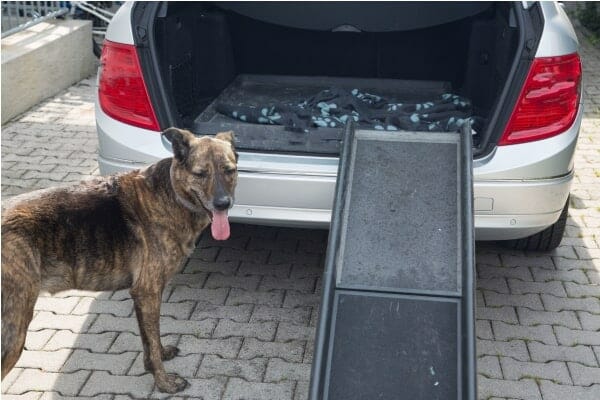
3. Support and lifting harnesses
Dog lifting harnesses make my list of favorite things for senior dogs for the sake of the dogs and their people. Here’s why:
1. A lift harness helps the dog enjoy more mobility and activity. (Obviously the goal!)
2. The harness also helps prevent the pet parent from injury. (Ergonomics matter when helping dogs maneuver.)
The two harnesses I recommend for my patients are the GingerLead® Support and Rehabilitation Harness, and the Help ‘Em Up® Mobility Harness. Both are well made and offer a patented design to help dogs with weak legs have more freedom and mobility.
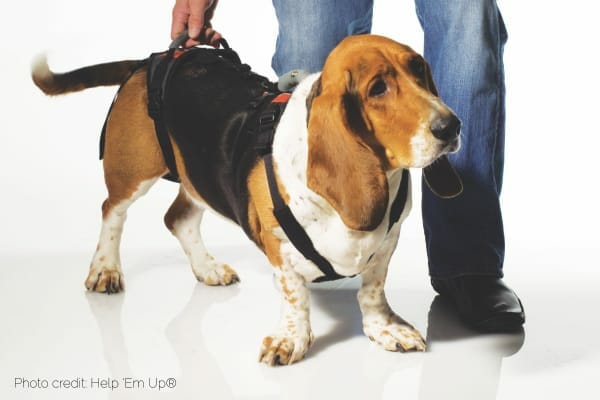
The Help ’em Up harness is a lifting aid that straps around a dog’s torso and legs and is designed to be worn all day. When I have canine patients who can’t get around by themselves and require significant help to rise, I recommend the Help ‘Em Up harness as a semi-permanent accessory.
The GingerLead dog support and rehabilitation harness is a walking aid that is quick and easy to put on and take off. It is designed for support on-demand, but not intended to be left on the dog. For dogs that just need hind end support when rising or gaiting, the GingerLead is a quick, comfortable, on-and-off solution.
4. Dr. Buzby’s ToeGrips® dog nail grips
Dogs use their nails for traction. On earthen terrain, they flex their paws and dig in their nails like cleats. But on hard floors, their hard nails can’t get a grip. Young dogs generally compensate for this without a problem. But due to muscular weakness, joint disease, and slower reflexes, older dogs often struggle to compensate. Slipping is scary and takes a toll on both mind and body.
For several reasons, I don’t approve of dog boots, dog booties, or dog socks as a traction solution for dogs. Throw rugs and runners, placed strategically throughout the home, used to be my recommendation for my slipping patients. But inevitably, the dogs would still go lie on cold hard floors and later face the challenge of getting up off those floors.

He is wearing the blue nonslip grips, which are size medium.
Then a client of mine presented me with the idea of using rubberized grips on dogs’ toenails, leveraging the dog’s natural traction mechanism. My client, an entrepreneur with many other projects on his plate, suggested I be the one to carry the torch of bringing the idea to life. So my patented product, Dr. Buzby’s ToeGrips® dog nail grips, were born.
The nonslip nail grips fit onto dogs’ toenails to enable traction, reduce the risk of slip-and-fall injury, and improve mobility and stability. ToeGrips have transformed my patients’ lives and restored their freedom of mobility to enjoy their family uninhibited by slippery floors!
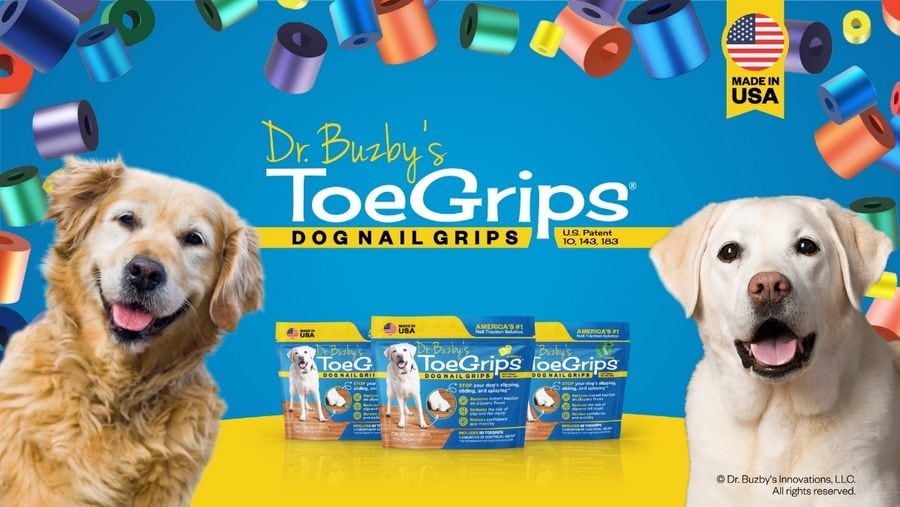
Best things for senior dogs: 7 supplements and medications to support your senior dog’s mind, joints, and body
There are a several supplements, medications, or foods that I routinely recommend to my senior patients.
1. Omega-3 fatty acids
With few exceptions, omega-3 fatty acids are safe and beneficial for dogs, especially those entering their senior years. Omega-3s reduce inflammation throughout the body, benefiting everything from hips to brain (plus the joints and organs in between). I recommend this supplement for my canine patients with arthritis, doggie dementia, kidney failure in dogs, heart disease in dogs, and skin problems/allergies.
Omega-3 fatty acids are not often considered a “first string” choice for the management of arthritis in dogs. However, I contend that perhaps they should be. There is scientific data to back the anti-inflammatory effects of omega-3 fatty acids, and you have virtually nothing to lose by trying them.
The only contraindication is that fatty acids can increase blood clotting times. For this reason, I recommend stopping them a week or two before a planned surgery and not using them if your dog has a bleeding disorder.
2. Senilife® for the older dog’s aging brain
Over the years, I’ve had clients joke about their older dogs having dementia, senility, or sundowner’s syndrome in dogs, not realizing that they’re probably exactly right!
Canine cognitive dysfunction (senility) is a bonafide diagnosis for senior dogs. It impacts quality of life for the dogs and their caretakers because symptoms include pacing, restlessness, and senior dog anxiety at night. Their owners are often exhausted from the intensive care their canine companions require, especially overnight. Every little bit helps in improving quality of life for these dogs.
Years ago, I remember a well-respected veterinary colleague saying in one of her conference lectures that Senilife® was a game-changer during her own dog’s golden years. I began using it in my practice shortly thereafter with good results.
Senilife contains Phosphatidylserine, Pyridoxine, Gingko Biloba, Reservatrol, and D-alpha-tocopherol (Vitamin E). These antioxidants have a protective effect in the central nervous system to reduce symptoms of “cognitive decline.” Senilife can start to improve symptoms in as few as seven days. Also, it is considered safe, even if your dog is on other medications or supplements.
According to a 2007 study in the Journal of Applied Animal Behavioural Science, “Dogs treated with Senilife® showed a highly significant difference…Preliminary results from dogs on Senilife showed a marked improvement of cognitive dysfunction syndrome related signs, even if the dogs failed to show a complete remission of symptoms.”
I think this translates to mean that Senilife may not be a miracle cure, but the product does help as claimed. And that’s why it makes my list of favorite things for senior dogs.
3. Purina Bright Minds® nonprescription, over-the-counter dog food
I normally don’t discuss pet food brands, but this one deserves a spot on my A-List of essentials for senior dogs.
Purina’s website claims that Bright Minds contains “enhanced botanical oils shown to promote alertness and mental sharpness in dogs 7+, with visible results within 30 days.” I can’t disagree with their claim. I’ve seen some pretty amazing changes in older dogs once starting this diet, though not all respond.

The premise of the diet, which was supported by a scientific study on aged Beagles, is that when feeding a diet rich in MCTs (medium-chain triglycerides), the brain runs on an alternate energy source—ketones—and mental function improves. A 2010 study published by the British Journal of Nutrition described the mental acuity in dogs on this diet as “significantly better” over the control group.
(Interestingly, a 2015 study published by the same journal showed improvement for dogs with epilepsy fed a similar MCT-rich diet.)
Although there are other diets on the market with a similar formula, namely Purina ProPlan NeuroCare® and Hills b/d™, I choose Bright Minds because it is the only over-the-counter dog food of its kind. The others are veterinary prescription diets.
Note: For Bright Minds (or other prescription diets) to be effective, it should be fed exclusively and not mixed in with regular dog food.
4. Dr. Buzby’s Brain Boost MCT oil for dogs
If you like the idea of supporting your dog’s brain health but would prefer to do it using a supplement rather than a dog food, an MCT oil supplement designed specifically for dogs may be the way to go.
This is a great option for dogs who are picky eaters, those who need to be on a prescription diet for other health issues, or households where the dog parent prefers to feed all dogs the same food and then add supplements to a specific dog’s food as needed.
To recap what we discussed earlier, MCT oil for dogs has two main benefits that help improve cognitive function in dogs:
- MCT oil provides ketones that the brain can easily use for energy. This is great because the brains of senior dogs tend to not be able to use glucose, the normal brain fuel, as easily as they used to.
- MCT oil has the ability to help protect the neurons from damage, support the growth and repair of neurons, and reduce inflammation.
When I learned about the benefits of MCT oil, I searched for an MCT oil product I could stand behind. However, I was unable to find something I could endorse, so our veterinary team developed one—Dr. Buzby’s Brain Boost™ organic MCT oil for dogs. It is easy to add to your dog’s food, dogs love the taste, and it gives their brains the boost of energy they need!
5. Glucosamine and chondroitin (joint supplements)
There is significant debate in the scientific community over whether glucosamine supplements (and their “kin”) provide any joint health benefit to people and animals. I think advocates on both sides of the argument would agree that additional clinical studies would be ideal because the results are mixed.
However, I personally believe the scientific evidence which concludes that oral glucosamine and chondroitin, the two most common ingredients in joint supplements, are absorbed as intact molecules and improve joint mechanics.
These compounds are thought to increase joint fluid quality and promote joint cartilage health. To be more specific, glucosamine affects collagen production in cartilage and may actually have some anti-inflammatory properties. And chondroitin counters enzymes that cause damage to joint cartilage.
I start my own dogs on glucosamine and chondroitin when they are middle aged to help protect their joints. But these supplements are even more important for senior dogs with degenerative joint disease.
It may take up to four to six weeks for results, but most people see improvement in their dogs within two weeks. Every single one of my patients with arthritis is on a joint supplement. I do this because there is potential for significant gain with very little risk. I’ve seen a few dogs experience mild gastrointestinal upset (like diarrhea and gas) from glucosamine supplements, but the vast majority tolerate them very well.
Hip and joint supplement products
For our senior dogs who get stiff and sore, my favorite source of glucosamine and chondroitin (plus a host of other beneficial components) is a combination of Green lipped mussel and New Zealand deer velvet. These ingredients help heal and support joint cartilage and improve the lubricating and cushioning qualities of the joint fluid. Plus they contain omega-3s, which have great anti-inflammatory effects.
I stand behind these two all-natural super ingredients so much so that I worked with veterinary colleagues around the world to formulate a supplement that I could put my name behind, Dr. Buzby’s Encore Mobility™ hip and joint supplement for senior dogs. Containing only a unique combination green lipped mussel and New Zealand deer velvet, Encore Mobility has helped thousands of dogs rediscover their inner puppy.

Advice for choosing a joint supplement for your senior dog
Because joint supplements for dogs are just that—supplements—they are not regulated by the FDA. This means that manufacturers don’t fall under the strict regulation that drug manufacturers do. Thus, what’s on the label may not be what’s in the bottle (in terms of quantity of active ingredients). The quality varies significantly.
I really think when it comes to choosing a joint supplement for your dog, it is “buyer beware.” Keeping these points in mind can be helpful.
- It’s not necessarily wrong to use human joint supplements on your dog, but the dosing can be confusing.
- Quality is key. More than likely you get what you pay for. High-quality products produced carefully are expensive. If you’re getting a month’s supply of something for $11, I’m worried.
- Most joint supplements recommend starting with a “loading dose” for four to six weeks. And then you reduce to a “maintenance dose.” For my patients with severe joint disease, I keep them on the loading dose indefinitely.
- Ask your veterinarian’s opinion on which joint supplement she or he recommends and why. The major veterinary brands of glucosamine and chondroitin products tend to be of good quality, produced under strict standards, and tested in controlled studies.
- There are other compounds that can be present in joint supplements, such as MSM (methylsulfonylmethane), avocado/soybean unsaponifiables (ASU), green-lipped mussel for dogs, and herbs. These can also be beneficial for your older dog.
6. Adequan for dogs
What would you say if I told you there was a way to slow down the progression of arthritis in your senior dog? Turns out, it is possible!
Adequan for dogs is an injectable disease-modifying osteoarthritis drug (DMOAD). It works by improving the quality of the joint fluid, supporting cartilage health and production, decreasing inflammation, and blocking enzymes that destroy cartilage in the joint. All this translates to less damage to the joints and less pain.
Typically, the vet will administer the Adequan injections more frequently at first (potentially twice a week for four weeks). Then the dog moves into the maintenance phase where injections may be every one to four weeks instead. Sometimes you can learn to give the injections at home. Otherwise, you will need to bring your dog to the vet to get the Adequan injections.
7. Veterinary-prescribed, non-steroidal anti-inflammatory drugs (NSAIDs) and other pain medications
I’m an integrative practitioner who’s certified in animal chiropractic and veterinary acupuncture. But I’m here to tell you that sometimes medications like veterinary-prescribed NSAIDs are appropriate and necessary as part of the management of pain and mobility for senior dogs. I’ve seen first hand the giant leap of improvement dogs can make when they are given the opportunity to experience “better living through chemistry.”
Veterinary science considers NSAIDS the gold-standard treatment for dogs suffering from musculoskeletal pain like arthritis. Starting your dog on veterinarian-prescribed NSAIDs like carprofen for dogs can instantly “take years off his or her life.”
Of course, NSAIDs are not without side effects and even contraindicated for some patients. In the article “What Are the Benefits of Long-Term NSAIDs?”, Veterinary Practice News does a thorough job of discussing the pros and cons of long-term NSAID use for older dogs.
(Please note: Never give human NSAIDs (i.e. Aleve or Advil) because they can be dangerous for dogs and lead to gastrointestinal issues and damage to the kidneys.)
Additional methods of pain control
Often used in combination with NSAIDS, pain medications like tramadol for dogs, gabapentin for dogs, and amantadine for dogs can be helpful in restoring comfort and quality of life for “creaky” older dogs.
Plus, there are a variety of options for natural pain relief for dogs such as PEMF mats or beds for dogs. It can also be helpful to work with a veterinarian who offers alternative methods of pain control such as acupuncture for dogs, laser therapy for dogs, massage therapy, or chiropractic care for dogs.
If you live with a senior pet who is slowing down and is not receiving any medications or therapies for arthritis pain control, I would strongly recommend initiating a conversation with your veterinarian. There are so many options for making your dog more comfortable!
Best things for senior dogs: 6 products that can help you care for and interact with your senior dog
Some of the following tools make it easier to care for your senior dog. Others may build your bond as well as provide mental and physical benefits for your aging dog.
1. Puzzle toys and other mental stimulation activities
In older adults, playing games or doing puzzles can help improve cognitive health. And the same is true for our furry friends.
I highly recommend making it a habit of doing mental stimulation toys and games with your senior dog on a regular basis. Not only can puzzle toys, snuffle mats, and thinking games help keep your dog’s brain sharp, but they also help improve your bond. There are so many different options so you’re sure to find something that works for your pup! Plus, mental stimulation toys make fun gifts for senior dogs.
2. A leash (for your dog) and a pair of walking shoes (for you)
It may sound simple, but the benefits of regular exercise for senior dogs can’t be underestimated. (And it is good for dog parents too!)
The Dog Aging Project released the results of their study on physical exercise and cognitive decline in senior dogs. After evaluating over 10,000 dogs in the study, it became clear that physical exercise boosts brain health in senior dogs. This is great news because it gives us one more way to help fight the onset of cognitive decline.
Plus, low impact exercise is great for keeping your senior dog’s muscles strong and joints limber. This can help decrease arthritis pain and improve mobility.
Keep in mind though, that if your dog isn’t used to exercising, you will need to start gradually. Also, if your dog has arthritis or other mobility concerns, please consult your vet before starting an exercise program. He or she can advise you on how to help your dog exercise safely.
3. A pill organizer
If you share your home with several senior dogs, or have a senior with a condition that requires long-term medication, you may have a corner of your counter or cabinet that is packed with pill bottles. This can sometimes make it hard to find the right medication for the right dog. And you don’t have a good way of knowing if someone else in the household already gave the medication.
Enter the pill organizer box. It isn’t just for humans who take lots of pills…
By organizing your dog’s pills into a weekly pill box, you can simplify your medication and supplement routine. Plus, if the box for that day and time is empty, you know your dog had his or her meds. No more trying to track down your spouse or kids or wondering if you actually gave the meds or only meant to give the meds and then got distracted.
4. Raised food and water dishes
For senior dogs, having raised food and water dishes can make eating and drinking more comfortable. This is especially true for dogs with arthritis or neck or back pain.
There are a variety of elevated feeders available. Ideally, you would find one that holds the bowls at or slightly below chest height. You want your dog to be able to reach the bowls without having to bend down. But you also don’t want the feeder to be so high that your dog has to stand with an unnatural neck position to get to the food or water.
5. Light-up collar or harness and night lights for the home
As your dog ages and his or her eyesight declines, it might be a harder for your dog to see in the dark. Additionally, a dog with dementia could potentially get lost in the yard and forget how to find the door to the house.
A collar or harness with a light on it (or a light you clip to the collar or harness) can solve both those problems when your dog is outside. It gives your dog some light to see where he or she is going. Plus, it makes your dog stand out in the dark so you can easily keep track of him or her.
When it comes to navigating around the house, putting night lights in the hallway, near the stairs, and in rooms your senior dog frequents can help him or her see better in the dark. As a result, your older dog can move about the house with more confidence.
6. An abundance of love and companionship
While I’m sure I’m preaching to the choir, your love and companionship go a long way in keeping your old dog comfortable. Yes, walks may be shorter. Head rubs are gentler. But your dear old friend still loves every moment shared with you.
Which of these things do you plan to try out?
If you have the privilege of sharing your life with a senior dog, or a dog who is approaching his or her senior years, why not take a few minutes to consider trying out some of the things on this list? Maybe you want to commit to increasing your dog’s mental and physical activity. Or perhaps you are going to research and then purchase a ramp, harness, or supplement.
Whatever it is, I hope that it makes life just a little sweeter for you and your beloved senior dog.
What’s on your list of the best things for senior dogs?
Please share your favorite things for your aging dog in the comments below.
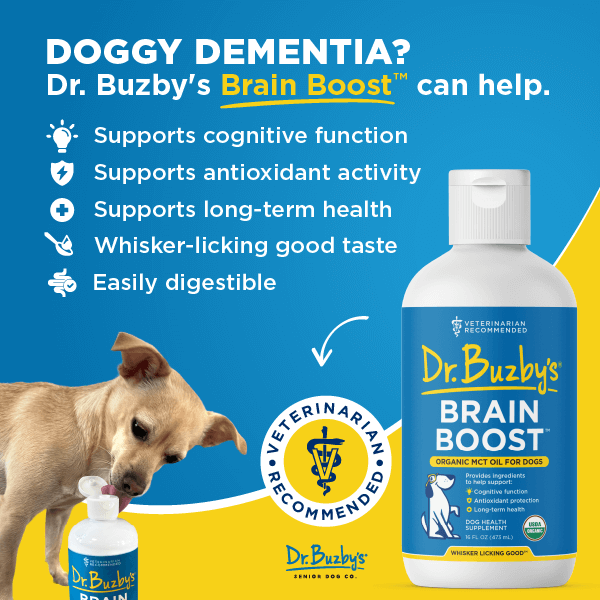


For everyone with an older dog, especially one with dementia (cognitive dysfunction), I do recommend this book, by Eileen Anderson,
Remember Me?: Loving and Caring for a Dog with Canine Cognitive Dysfunction or the companion website: https://dogdementia.com/
No, it does not tell you about a magic pill, but it explores/suggests ways to make things easier for the dogs and their humans.
Older dogs can get anxious/agitated at night time, not unlike humans with Alzheimer’s.
*** I found that sometimes the solution is to lie down along/against them, preferably in a calm and somewhat dark environment, and stroke them softly on the head (you can also gently use the ocular compression method (http://www.canine-epilepsy.com/Ocularcompression.php). It does calm them down – and it may take only 5 mn to start working!!! – then if you are not asleep too, you can get up quietly and go to your own bed.
*** I used Composure or Covetrus “Behavior Chews” at night time, two similar supplements to calm pets down. I really think they help.
*** Try a thundershirt-like outfit, I think they sometimes help. I prefer the 2 brands below to other brands (including the Thundershirt brand) because they cover a larger part of the body (mainly the chest), and from what I read, it makes a difference by stimulating pressure points (and they are not expensive):
– Comfort Zone Calming Vest (I don’t think they make it anymore but you can still find it on eBay)
– Kong Dog Anxiety Reducing Stress Relief Shirt for Dogs.
*** Try feeding, I don’t know why but it worked several times: after eating, my night-time-agitated dogs went back to sleep.
Hi Marie,
Thank you for offering these suggestions. Best wishes to you and yours!
Enjoyed reading all the favorable comments. My senior companion, Maggie, has severe arthritis in her hips. She is a rescue, lab/retr. mix, 71 lbs. I tried the “toe grips” and found then tooo hard to apply; she moved every time I tried to put them on and I am in my 80’s and hard to get back up. I then tried the dog socks; they worked better, but the velcro strap (to tighten around the paw) was challenging. I have since sent for and am using yoga matts and they truly are a “God sent” addition to my kitchen floor and not expensive.. Very easy to clean with a Swifter, also. Now, I am trying CBD chewies and would appreciate any favorable comments or/and suggestions. Particularly pros/cons.
Hi Barb,
I am sorry Maggie is living with arthritis pain but glad to hear you are searching for ways to keep her comfortable. CBD products could be the solution you are looking for, but the only way to know for sure is to try them and see how your girl responds. Please talk to your vet before staring any new supplement to ensure it will not have a negative interaction with any other medications or conditions Maggie may have. I would offer a word of caution about gummies as they frequently contain xylitol which is toxic to dogs. Here is a link to another article with more information: CBD Oil for Dogs: Facts, Benefits, Concerns [2024]
Also, the company ElleVet makes CBD products for dogs that have been tested for efficacy and the company adheres to strict manufacturing and quality control standards. Here is a link to their website for details: https://www.ellevetsciences.com/pet-care/setting-the-standard-for-the-best-pet-cbd-oil/
Hoping you can find what works best for your pup. Wishing you and Maggie all the best!
Thank you for all the information you allow pet parents! my 16 yr. old “Spike” has shared his entire life with me. We have lost his daddy and sister in the past 2 years and have been a significant source to heal and cope for each other. We survived a fighting dog attack on both of us and Spike fought back..so did I. He is healthy and physical with normal and sad eye and hearing losses. My concern is his eating habits are unreliable and even enticing meds do not always help. I’ve tried every type/brand/texture/flavor for about 6 months now since his sister, Daisy passed. He’s even picky about treats! He sees his vet often and is healthy every other way and test. Our bond is so strong. Please help! THANK YOU.
Dear Karen,
I am sorry you and your senior boy have endured so much over the past two years. I understand your concern with his picky eating behavior and wish I knew what to recommend. It is possible he is still grieving the loss of Daisy and may just need more time. Here is a link to another article that may offer some insight: Do Dogs Grieve? Helping Your Dog Cope With Loss
As long as your boy is maintaining a healthy weight and his vet isn’t finding any abnormalities on the health screening tests, I say try to be patient and don’t let this get you down. You are doing a great job. Bless you. ♥
I find Dr. Buzby’s blog incredibly helpful. Just saw this blog post today (12/8) but after much research coincidentally ordered the Help ‘Em Up harness for our 15 year old hound/lab mix yesterday. Primary uses will be to help me help him get in and out of the car, and do stair assists. Happy to see it recommended here 🙂 Also wanted to mention that while meds and supplements can be helpful, each pet has its own unique reaction. For example, we tried Senjlife for about four months, and after a while it seemed to increase our pup’s pacing and anxiety. Gabapentin had the opposite effect – made him more confused and unsteady. After discussing it with the vet, we dc’d both and he now gets a probiotic (Purina Calming Care) which seems to strike the right balance. Also, as dogs (and humans) age, the ability to metabolize drugs and supplements changes, and the dose may need to change as well. Vet is trying him on a lower dose of levothroxine (his bloodwork tests out at the high end of the acceptable range) as recent clinical studies have found a possible correlation between higher doses and dementia in older human adults. This is not to say that a human study is applicable to dogs, but given his test results and his age, I think it’s is worth a try.
Hi Lisa,
Thank you for the kind words about the blog. That is very interesting about the levothyroxine dosage! Glad you have found a calming supplement that offers the beneficial effects you were hoping for. I appreciate you being willing to share your experience with our readers. Wishing you and your sweet boy many happy days ahead. ♥
Our 9 year old German Shepherd is getting slightly hard of hearing. We are teaching her and our 10 year old Golden hand and sign language. We have two Big Barker Beds, We use the sheet to help lift them in the car. They’re both on Cosequin with MSM and HA. They both get NurtriVed OFA.
I checked out the SeniLife on Amazon and put it on the Wish List if we need it.
Galliprant for the Golden was a big game changer for her.
Hi Teri,
This all sounds amazing. You have two very lucky pups! Keep up the good work.
I don’t understand how Big Barker beds are not only *not* number one on the list, but not on the list at all. They’re the only bed backed by science and I’ve never seen a bad review (which is saying something because there’s always somebody complaining about something). Talk about pricy, sheesh! But worth every penny. I don’t work for them I just tell everyone I know about them. Picking up the SUV liner (after the holidays so my checking account doesn’t go on strike) because it’s just an awesome product.
Raised feeders. I have a 14 y/o Boxer/Mastiff and an 8 y/o Great Dane. Eating shouldn’t be a task to be contended with and their appreciation for raised feeders is noticeable.
Can confirm the lifting harness. My dogs don’t even try to get in the car until I put the harness under them. It’s essentially a glorified towel, but it has handles and a wide, comfy belly strap.
Also agree with another commenter on collar lighting, but would add a beacon of some kind for the human too if you’re one to let your dogs off-leash at twilight or later. It’s been a game changer for my pups. They’re more comfortable stopping to check their pee-mail when they can easily look up and spot me.
Seniors are the absolute best! It truly amazes me that more people aren’t scooping them up out of shelters and rescues. They’re loyal, calm, well-behaved, and perhaps most importantly, potty trained! They’re all I adopt anymore.
Hi Jessicah,
Thanks for your advice and feedback about the article. Glad to meet another fellow senior pup lover like myself! Best wishes to you and yours. ♥
In the three years I had my geriatric [age 14], rescued Dutch Shepherd, I always lifted him in and out of my SUV which had the seats down with the surface covered in dog beds topped by a blanket. The only time he tried to jump into the car was after we’d attended a protective dog sports event – schutzhund, etc. – which featured bite sleeves and all the activities at which he used to excel. When the bite sleeve was tossed aside, he rushed to the fence to try to grab it as well as joyfully barking [he was trained not to bark and never did. This was his only time.] He was so energized by this visit that he tried but failed to jump into the car. Before that and from then on, I always lifted him in and out of the car.
On permitting the jumping in and out of cars by larger dogs, regardless of age. When an acquaintance took her GS to a local training session featuring a German trainer, she reported that that trainer had a fit when he saw an attendee let his GS jump in and out of the vehicle. The German [from Germany] trainer told the owner that never again should he ever let his dog jump in and out of the car. Always lift, carry, or otherwise assist the dog. If the owner wasn’t willing to do this, the trainer would take that dog then and there to give it a more appropriate home.
I understand that in Germany conscientious owners never permit young GSs to run full out. They’re carried up and down stairs to prevent injury, especially at a young age.
As for dog beds, Jiri [year-she, that’s Czech for George] always slept on an orthopedic bed topped with a softer bed. He stayed on the first floor, so at night I covered him with a blanket.
Later on, I did use a ramp for coming and going on the front steps.
He was worth every consideration.
Hi M.H.,
Thank you for sharing your experience with us. It sounds like Jiri had such a fulfilling life! I hope your wisdom and perspective will be a valuable resource for other readers. Best wishes.
I guess some of my favorites don’t necessarily pertain to seniors, but I’ve used these things for my sweet senior shih tzu. He recently had surgery to remove some bothersome sebaceous adenomas. I got him some silicone boots (his rain boots ?) to keep his bandages clean and dry outside.
He also gets highly resistant staph infections, for which the best antibiotic would be amikacin after we did a culture. BUT douxo mousse and shampoo have eliminated the need for antibiotic injections. Thank goodness, because the amikacin was hard on his little body. I bathe once a week and apply the mousse to active lesions once daily in between baths. This is what works for us, but definitely refer to your veterinarian or vet dermatologist before using.
I have k&h heating pads in his orthopedic cave bed. He loves the extra warmth it provides.
Lastly, never underestimate a good medication bin and pillboxes! I have everything corralled in one spot specifically for the dogs. It has a lid so I don’t have to look at that mess all day. Pillboxes keep everything organized and make med time go much quicker.
P.s. I love your podcast and miss it. I learned so much from you there!
Hi Keli,
Thanks so much for sharing this great list of favorites with us. I’m so glad the podcast was helpful to you too. ❤
As pet parent to (2) senior, large breed dogs -I’ve become a self-proclaimed guru on Senior Pet needs.
Some of our favorite items are:
1) “Canna-Pet” CBD; we’ve been off all prescription pain meds (for a variety of ailments) for 3+ years now thanks to CBD
2) “Ark Naturals Gray Muzzle Brain’s Best Friend! “supports cognition, recognition, memory, and learned skills with amazing vitamins and antioxidants that are all-natural. My dogs get these small snacks daily & we’ve seen a definite improvement.
3) “Nutri-Vet Cetyl-M Advanced Joint Action Formula Tablets Dog Supplement” – this has worked wonders for our 98lb boxer’s arthritis and GOLPP. He was having difficulty getting up from lying down – but after the initial period (approx 2 months) he’s doing 100% better.
4) As noted in the blog above, stairs and ramps are great. We have a great ramp for our SUV, but noted that even jumping out of our small car (Corolla) – it was jarring on their joints, so I picked up the “Pet Gear Easy Pet Step” from Chewy and it’s perfect for my car and for large breed dogs. Just that one step makes all the difference and they are no longer sore after a ride in the (smaller) car.
5) Collar lighting. This is a good product for all dogs – but more so for my seniors as their eyesight isn’t as great as it used to be, esp. in the dark. We’ve always used “Nite Ize Spot Lit” clip on lights on their collars – but recently purchased “Derlights Dog Light with USB Rechargeable, Clip-On Dog Collar Light, IP65 Waterproof Led Safety Emergency Dog Lights for Night Walking Running Cats Pet Camping or Bike, 2 Pack” from Amazon and WOW are they bright! They’re great for my dogs to see & be seen and bonus, they’re USB rechargeable!
Super helpful and actionable thoughts, Jenn. Thanks so much for sharing! I love that you’ve earned “guru” status due to the needs of your 2 senior dogs. ❤️
Great info love the ideas and especially for the Senilife my 14 year old chuwawa pappion mix definitely gets sundowners and the restlessness still night. He’s already in gabopentein tramadol and metacam for Arthritis poor boy was just made a little bow legged/. But Would love to get home more peaceful at night. He also likes the couch or chair a lot eight. Write he nods off to sleep. Someone told me it’s called mulling – self soothing …
Thanks so much for your comment, Sheila. You may find this blog helpful as well: https://toegrips.com/canine-cognitive-dysfunction-in-dogs-signs-solutions/
Beds are good for ailing dogs. Our almost eleven year old Pom had to be put to sleep a week ago due to liver cancer. Came on very quickly but what we noticed was she did tend to use the dog beds we have in our home more the last week of her life. Maybe it helped somewhat on her breathing.
Now our fourteen year old five pound dog has had cataracts since age eight. Scared to go on walks. The last several months she would sometimes get confused in the house and also poop and walk in it. Our solution was we bought one of those dog corrals where it has room for a soft dog bed and her food and a little bit to walk. She has had some poop accidents but it is contained to one spot.
Our little one still gets lots of cuddling. Doesn’t like walks. They scare her.
I’m so sorry to hear of your recent loss of your Pom. I know how hard that is.
Thank you for sharing your experiences with us.
We have an 11 year old yellow lab who enjoys a nightly game of hide and seek. Every night at about the same time, we break up a dog biscuit and begin the game. We throw part of the biscuit in our bedroom where he runs to get it. We then close him in the room while we hide the rest of the biscuit somewhere else in the house. We then let him out of the room and he has to use great his nose to find the rest of the treat. This nightly game seems to have helped keep his brain engaged and challenged. If we haven’t started the game at the expected time, he will “remind” us.
My 15 yo Pug-Wawa (pug x chihuahua) is, unfortunately, shoe signs of “sundowning.” I have been using a Snuffle Mat with her to encourage her mental stimulation (as well as good ol’ fun.). I suspect that’s a brand name, so when I talk about it I usually say sniff mat. It’s essentially a lot of felt-cloth configurations attached to a mat. You hide kibble or treats all over it and your senior (or any age) baby sniffs them out.
Another thing I’ve recently begun doing is providing her with things that smell like me. She’s no longer cuddling with me on the couch or resting in her bed in the living room in the evenings. Instead, she goes to her bed in our room for the night. When I come in, she often looks confused, as if she’s not quite sure who I am. It breaks my heart because she is often shaking, as well. I’ve taken to gently wrapping her in a sweatshirt I’ve worn recently, and even offer her a pair of socks I wore that day (about as smelly as one can get!) and she truly looks comforted. That plus hugs and words of love (which she can’t hear but may feel the vibration) really allow her to settle.
Hi Lora,
Thank you for offering advice and encouragement to others navigating this difficult path. As I’ve told you before, you are such an inspiration. I loved the wonderful video you sent. Keep up the good work and give sweet Bella Bean a hug for me! ♥
I’d like to share my experience with canine acupuncture. I had always believed that any benefit of acupuncture was a placebo effect (power of positive thinking) When our white german shepherd grew old, and suffered with hip and other mobility issues, we were willing to try anything. Our vet suggested acupuncture and I became a big believe in 20 minutes! Following a treatment our Cheyenne was so visibly improved! She would leave treatments with a long missing ‘spring in her step.’
Thanks so much for sharing your experience, John! I am also a believer, having been certified in veterinary acupuncture for 20 years. We are spotlighting this modality in an upcoming post! Thanks!
I just added your toe grips to my post on what senior chihuahuas need.
I have used them for one of my dogs with great results.
I don’t know why I didn’t think of adding them to my article before now but your article reminded me about them.
Thanks so much for including ToeGrips in your article, Cathy! We really appreciate you sharing ToeGrips with your wonderful, Chi-loving readers! 🙂
I agree that the Help ‘em Up harness is a Godsend! With it I can easily assist my senior Golden in getting up and now that she is wearing the toe grips, she can ambulate independently without slipping all over the floor. I tried the Bright Minds but she didn’t like it. I am definitely going to try the Senilife. She takes an NSAID, and Dasuquin with MSM. She also gets ADEQUAN injections every 3 weeks which have helped her immensely. She will be 15 next month and we are so appreciative of any suggestions to improve the quality of her life. Thank you for introducing the toe grips. They have made a HUGE difference
Thanks so much for your comments, Anne! I’m thrilled to hear that your dog is thriving with ToeGrips! And I also love Adequan. I’m including it on my second list (next week). I love hearing your experience. Thanks again!
We were privileged to share our home with 2 elegant long legged, well muscled greyhounds, the 1st ’til he was 17! & the 2nd for the next 9 years, learning that they needed their bowls placed well above floor level in order to eat & drink without uncomfortable straining, Now personalized feeding levels also apply to my short legged senior terriers. I place their dishes on a small platform closer to their mouth, so less strain. It’s not as obvious but an extra little stretch to an aging small dog can be just as uncomfortable as a big stretch for a big dog. Also true when my 4# toothless, tongue-out-the-side-of-her-mouth Yorkie is able to drink more comfortably when the water is in a higher bowl and she doesn’t have to submerged her nose to get her mouth close enough to drink sideways, her personal challenge. She just goes up to the mouth-high bowl and laps sideways. !She will not use a straw, she’s environmentally conscious.!
Ani, I love your first sentence so much! It captures the joy of living with dogs! Great tip on being conscious of the level of food and water bowls. Thanks for sharing!
Massage therapy with light therapy and lots of treats.
We treated our 15 year old Irish Setter to weekly massage and light therapy treatments from Gavin at Pawsitively Zen Canine Massage. I think she especially loved all the treats that were part of the treatment. The treatments helped her walk and even manage going down the steep stairs on her own. It also significantly helped get her back on all fours and happily back to her prancing self after being attacked by another dog at the age of 14. In her younger days, she also benefit from chiropractic adjustments after all her rough and tumble play and the mishaps that happen from running at full speed all the time.
Great tips, Sam. Thank you for sharing. I am currently sitting at the American Veterinary Chiropractic Association annual meeting and couldn’t agree more with you about the benefit of chiropractic for animals. Kudos to you for being so proactive in the care of your Irish Setter. 15 is amazing!